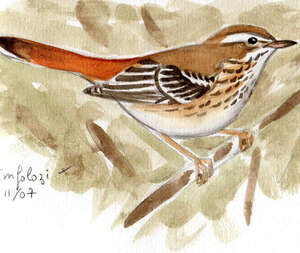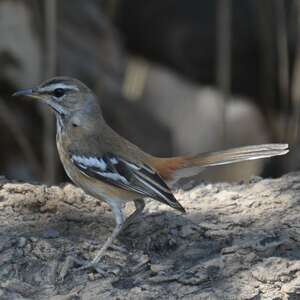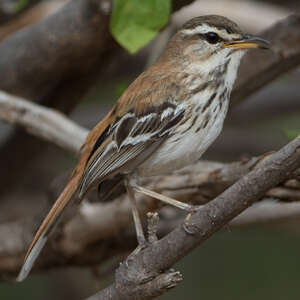White-browed Scrub Robin
Cercotrichas leucophrys - Agrobate à dos roux
Identification
The White-browed Scrub Robin has a brown back tinged with rust, a characteristic frequent amongst the birds of the genus. The adult of the type leucophrys subspecies has a beige-brown crown and nape, a warm brown mantle and back, a rufous rump and uppertail-coverts. The tail is blackish, edged and ended in white. The wings are also blackish brown, with two very visible white bars at the tips of the greater and medium coverts. The remiges are fringed with pale fawn, largely on the tertiaries.
The face is typical for a scrub robin, with a blackish line on each side top to bottom bordering the brown crown, a clean white eyebrow, a blackish loral line passing by the dark eye and continuing back, a chevron fawn underlined in brown, a wide white moustache separated from the white throat by a distinct malar line brown. A half-moon white serves as framing for the eye. The beak is dark grey, with the base of the lower mandible yellow.
The underparts are whitish with more or less pronounced brown streaks starting from the malar lines and extending to the chest and flanks, they are washed in rufous. The legs are pinkish grey. Both sexes are similar. The juvenile differs from the adult by a scaly-looking plumage.
The other subspecies (9) are overall rufous above and below, with the tail itself rufous and black and white-ended, the head more grey and contrasting, with more white on the wings. This last criterion is particularly noticable on the leucoptera subspecies. Munda has an intermediate tail. Ecological-ethological differences are also observable, such as distinct songs.
Subspecific information 9 subspecies
- Cercotrichas leucophrys leucophrys (s Zimbabwe, s Mozambique, n and e South Africa)
- Cercotrichas leucophrys leucoptera (s Sudan, s Ethiopia, n Somalia and n Kenya)
- Cercotrichas leucophrys eluta (s Somalia and ne Kenya)
- Cercotrichas leucophrys vulpina (e Kenya and e Tanzania)
- Cercotrichas leucophrys brunneiceps (c and s Kenya, n Tanzania)
- Cercotrichas leucophrys sclateri (c Tanzania)
- Cercotrichas leucophrys zambesiana (n and e DRCongo and s Sudan to w Kenya, e Zimbabwe and n Mozambique)
- Cercotrichas leucophrys munda (s Gabon to c Angola and w DRCongo)
- Cercotrichas leucophrys ovamboensis (s Angola and n Namibia to sw Zambia and w Zimbabwe)
Foreign names
- Agrobate à dos roux,
- Alzacola dorsirrojo,
- rouxinol-do-mato-estriado,
- Weißbrauen-Heckensänger,
- barnásfehér tüskebujkáló,
- Witbrauwwaaierstaart,
- Usignolo dorsorosso,
- vitbrynad trädnäktergal,
- Hvitbrynkrattskvett,
- žltorítka savanová,
- pěvec pruhokřídlý,
- Plettet Trænattergal,
- viiruruostepyrstö,
- Gestreepte Wipstert,
- cuaenlairat de carpó vermell,
- drozdówka jasna,
- Белокрылый тугайный соловей,
- フタスジヤブコマドリ,
- 白眉薮鸲,
- vitbrynad trädnäktergal,
- 白翅藪鴝,
Voice song and call
The White-browed Scrub Robin male sings at any time of the year. His song is strong and melodious. It is a rapid succession of notes with some repetitions, wuriit sii-titi-iou. The song varies depending on the region and subspecies. The call, commonly heard at sunset, can be translated as piip-bu go. The alarm cry is a loud note skirr or ski-ip. In a dangerous situation when the bird is frightened, a plaintive chiiyip is heard.
Habitat
The White-browed Scrub Robin frequents grasslands, particularly acacia savannas, scrubland, dry and open forests, such as Mopane forest in southern Africa.
It is found from sea level up to 1400 metres in eastern highlands of Zimbabwe and Mozambique. In the Horn of Africa, it occupies a wide variety of habitats with the exception of closed forests and desert areas, from sea level up to 1,880 metres. In East Africa, up to 2,200 metres and at least 1,720 metres in the Democratic Republic of Congo.
Behaviour character trait
The species is resident except in the extreme south of its range where the climate imposes displacement. Although generally common, its shyness and discretion make the species difficult to observe. It is easy to pass by in the absence of singing. As such, its habits are not well known, particularly its reproduction. Fortunately, it occasionally happens that the male sings at the top of a shrub, but this is not the general rule.
Flight
Dietfeeding habits
The White-browed Scrub Robin is primarily an insectivore. It searches for food on the ground by hopping and turning the vegetable litter like thrushes and blackbirds, raised tail feathers and descending wings.
It mostly feeds on termites, breaking their galleries and ants, but willingly adds moths, caterpillars, bugs, crickets and grasshoppers. On occasion it can catch spiders, wasps, centipedes and flies, even in flight. It also digs through the excrement of large herbivores to dislodge the coprophagic insects. Fruits are not scorned, nor is Aloe nectar in the winter.Reproduction nesting
Breeding takes place all year round, with the season varying in different regions. From March to May in Ethiopia to the north of the Equator, ayear round in the Equatorial Democratic Republic of Congo, mainly from April to May in East Africa, October to November in Angola, October to January in Rwanda, October to February in Mozambique, Malawi and Zambia, and from September to February, peaking in October to December in South Africa. The density of the couples per square kilometer ranges from high to low depending on the region and the environment. For example, it is locally common in the coastal areas of southeast Gabon and the Congo, but rare in Sudan on the edge of its range.
Pairs are territorial and nest separately. In the presence of the female, the territorial male parades with his wings down and his tail raised into a fan, becoming easily visible if he chooses the top of a shrub, but this is not always the case. He often sings, hidden in prickly bushes. The nest is a cup built by the female alone, at a low height (0-2 m) in a living or dry, often herbaceous tuft, usually at the base of a tree or in the shade of a prickly plant. An aloe can be chosen as support, with dead leaves forming a protective skirt. The nest is made up of dead plant elements, stems, leaves, bark and dry grass. It is lined with rootlets and dry leaves. It is not well protected, hence a high rate of predation on the nests, which leads the adults to renew their nests two to three times in different nests. The female lays 2 to 4 eggs, white, cream or fawn in color, with brown and purple spots. She broods alone for 12 to 14 days. The chicks are fed exclusively on insects by both parents for 11 to 12 days, and remain dependent on the parents for at least two weeks after they have flown.The species can be parasitized by different species of cuckoos, solitary, jackdaw, Klaas or didric. Predation by the Red Mangoose is frequent.
Geographic range
The White-browed Scrub Robin is a species of the south and east of Africa. Its range is south of a line from the Gulf of Guinea to the Gulf of Aden, stretching over all latitudes, but avoiding on one side the heart of Africa, too forested, and on the other the extreme southwestern part, too arid.
The species comprises 9 subspecies classified into two groups. On one side is the type subspecies leucophrys found in the extreme south of Africa, the one which has given the specific name White-browed which is somewhat ill-fated since its back can be less rufous than that of other subspecies such as vulpina, eluta or leucoptera for example. On the other, to the north of the first one, the remaining 8 subspecies grouped under the denomination White-winged, literal translation of leucoptera, the name of one of the subspecies. Ovamboensis, the most southern one, does not reach South Africa.
Threats - protection
IUCN conservation status
concern
in the Wild
threatened
evaluated
The White-browed Scrub Robin is common to abundant in Southern Africa and is generally not under threat. Its wide geographic distribution and its ability to adapt to dry habitats compared to its relatives play in its favour. It also doesn't seem to be very sensitive to habitat change.
Sources of information
- IOC World Bird List (v15.1), Gill, F and D Donsker (Eds). 2025-12-07.
- Birds of Africa South of the Sahara, Ian Sinclair and Peter Ryan
- Birds of the Horn of Africa, Nigel Redman
- Birds of East Africa: Kenya, Tanzania, Uganda, Rwanda, Burundi, Terry Stevenson, John Fanshawe
- Avibase, Lepage Denis
- Birds of Southern Africa, Tony Roocroft
- HBW Alive,
- Wikipedia (English version),
Other sources of interest
 Specification sheet created on
21/07/2023 by Nathalie Santa Maria
Specification sheet created on
21/07/2023 by Nathalie Santa MariaTranslation by AI Oiseaux.net
© 1996-2025 Oiseaux.net
- Accipitriformes
- Aegotheliformes
- Anseriformes
- Apodiformes
- Apterygiformes
- Bucerotiformes
- Caprimulgiformes
- Cariamiformes
- Casuariiformes
- Charadriiformes
- Ciconiiformes
- Coliiformes
- Columbiformes
- Coraciiformes
- Cuculiformes
- Eurypygiformes
- Falconiformes
- Galliformes
- Gaviiformes
- Gruiformes
- Leptosomiformes
- Mesitornithiformes
- Musophagiformes
- Nyctibiiformes
- Opisthocomiformes
- Otidiformes
- Passeriformes
- Pelecaniformes
- Phaethontiformes
- Phoenicopteriformes
- Piciformes
- Podargiformes
- Podicipediformes
- Procellariiformes
- Psittaciformes
- Pterocliformes
- Rheiformes
- Sphenisciformes
- Steatornithiformes
- Strigiformes
- Struthioniformes
- Suliformes
- Tinamiformes
- Trogoniformes

































